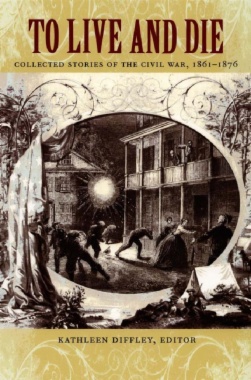Even before the first cannonballs were fired at Fort Sumter, American writers were trying to make creative sense of the War Between the States. These thirty-one stories were culled from hundreds that circulated in popular magazines between 1861 and the celebration of the American centennial in 1876. Arranged to echo the sequence of the unfolding drama of the war and Reconstruction, together these short stories constitute an “inadvertent novel,” a collective narrative about a domestic crisis that was still ongoing as the stories were being written and published.
The authors, who include Louisa May Alcott and Mark Twain, depict the horrors of the battlefield, the suffering in prison camps and field hospitals, and the privations of the home front. In these pages, bushwhackers carry the war to out-of-the-way homesteads, spies work households from the inside, journeying paymasters rely on the kindness of border women, and soldiers turn out to be girls. The stories are populated with nurses, officers, speculators, preachers, slaves, and black troops, and they take place in cities, along the frontier, and on battlefields from Shiloh to Gettysburg.
The book opens with a prewar vigilante attack on the Underground Railroad and a Kansas parson in Henry King’s “The Cabin at Pharoah’s Ford” and concludes with an ex-slave recalling the loss of her remaining son in Twain’s “A True Story.” In between are stories written by both women and men that were published in magazines from the South and West as well as the culturally dominant Northeast. Wartime wood engravings highlight the text. Kathleen Diffley’s introduction provides literary and historical background, and her commentary introduces readers to magazine authors as well as the deepening disruptions of a country at war.
Just as they did for nineteenth-century readers, these stories will bring the war home to contemporary readers, giving shape to a crisis that rocked the nation then and continues to haunt it now.
- Contents
- Acknowledgments
- Daily Emergency: Civil War Stories of theWar Generation
- Time Line
- Prelude
- Henry King, ‘‘The Cabin at Pharaoh’s Ford,’’
- 1861
- Chauncey Hickox, ‘‘Job and the Bug,’’ Lippincott’s (May 1871)
- Izilda, ‘‘A True and Simple Tale of ’61,’’ Southern Monthly
- Rebecca Harding Davis, ‘‘Ellen,’’ Atlantic Monthly (July 1865)
- 1862
- Richmond Wolcott, ‘‘Hopeful Tackett—His Mark,’’
- Fred B. Perkins, ‘‘Thomas Elliott’s Speculations,’’
- Nora Perry, ‘‘Mrs. F.’sWaiting Maid,’’ Harper’s Monthly (June 1867)
- ‘‘Believe in Ghosts!’’ New National Era (November 1870)
- William H. Kemper, ‘‘The Sergeant’s Little Story,’’
- ‘‘On the Antietam,’’ Harper’sWeekly (3 January 1863)
- Charity Grimes, ‘‘A Letter from the Country,’’ Harper’sWeekly
- Confederate Gray, ‘‘T. J.’s Cavalry Charge,’’
- 1863
- ‘‘Colonel Charley’s Wife,’’ Harper’s Weekly (8 October 1864)
- ‘‘The Fourteenth at Gettysburg,’’ Harper’s Weekly (21 November 1863)
- J. D. Imboden, ‘‘Lee at Gettysburg,’’ Galaxy (April 1871)
- Ellen D. Larned (Ellen Leonard), ‘‘Three Days of Terror,’’
- Louisa May Alcott, ‘‘The Brothers,’’
- Silas Weir Mitchell, ‘‘The Case of George Dedlow,’’
- J. O. Culver, ‘‘Robbed of Half a Million,’’ Harper’s Monthly
- ‘"In the ‘Libey’,’’ Harper’s Weekly (20 February 1864)
- Richard Malcolm Johnston (Philemon Perch), ‘‘Mr.Williamson Slippey
- 1864
- Ross Guffin, ‘‘A Night on the Mississippi,’’ Putnam’s (April 1870)
- G. J. A. Coulson (Alcibiades Jones), ‘‘Mrs. Spriggins, the Neutral,’’
- ‘‘Buried Alive,’’ Harper’s Weekly (7 May 1864)
- ‘‘A Night in the Wilderness,’’ Galaxy (May 1871)
- M. Shele De Vere, ‘‘The Freedman’s Story,’’
- ‘‘Road-Side Story,’’ Land We Love (August 1866)
- 1865
- Edward Everett Hale (J. Thomas Darragh), ‘‘The Skeleton in the
- Richard M. Sheppard, ‘‘Sentenced and Shot,’’ Lakeside Monthly
- Constance Fenimore Woolson, ‘‘Wilhelmina,’’
- Aftermath
- Samuel Clemens (Mark Twain), ‘‘A True Story, RepeatedWord for
- Author Sketches
- Illustration Sources
- Civil War Glossary
- Bibliographic Essay
- Index

